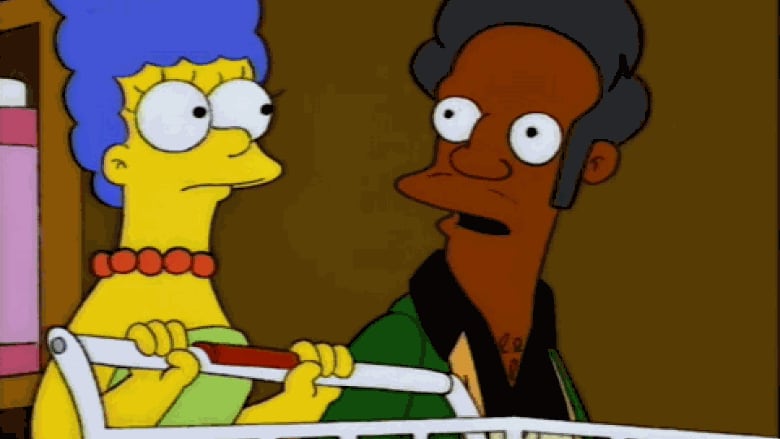The problems with The Problem With Apu
A recent documentary suggested the Simpsons character is offensive. Here's why that view is short-sighted

I toured India with comedian and filmmakerHari Kondabolu, so I love him not only as an artist, but also as a friend. It is in this context that I offer a critique of his documentary, The Problem with Apu, which tackles the depiction of Kwik-E-Mart owner Apu Nahasapeemapetilon on The Simpsons.
The documentary suggests that the way Apu is presented is offensive a charge that writers finally addressed in Monday night's episode, where Lisa breaks the fourth wall and says, "Something that started decades ago, and was applauded and inoffensive, is now politically incorrect. What can you do?"
Here's what I think: this documentary is well-done, and it is driven by a noble pursuit of truth and justice. But it puts forth an argument that will simply make a lot of people roll their eyes. When that happens, we actually take the progressive movement backwards.
'It's racist'
In the trailer for the documentary, we seeKondabolu interviewingSimpsons writer and co-executive producer Dana Gould, who says that certain accents sound funny to white Americans. Kondabolu then pops up and says, "It's funny because it's racist."
OK, seriously. You don't understand the Indian accent is funny to white people?And to other Indians? Many of us do the Indian accent in our stand-up acts to solely Indian audiences, and they laugh. The Indian accent sounds funny in the same way the German accent sounds evil. It just does it's like when a smart person finally admits he finds farts funny. There's no way a comedian doesn't understand this concept.
One stereotype about Indians is that we lack a sense of humour. That was often the first question we received when we did press junkets throughout India: "How are you going to make Indians laugh when they can't take a joke?" That was news to me: Indians have consistently been some of my best crowds.So, by going after Apu, this documentary may be attacking one stereotype but enforcing another. Now that's irony.
Apu's last name is Nahasapeemapetilon, so let's use another long word: anachronistic.Why release this documentary in 2017, when the character is over a quarter century old?
If the thrust of the argument is that there were no prominent Indians in America to counter Apu's depiction at the time he was conceived, well, take a look at all of the prominent South Asian voices included this documentary: Aziz Ansari, Russell Peters, Aasif Mandvi, Sakina Jaffrey and more. Indians are killin' it in Hollywood.
The very fact that we have so many famous and successful Indians to rebut the whole concept ofApu proves the point that the way to victory is to drown him out.If the best revenge is living well, as the expression goes,then we're clearly winning.
- 'That's a white guy making fun of me': comedian Hari Kondabolu's problem with Apu
- The Problem With Apu: new doc critiques South Asian stereotype
All comedy is misdirection. But the documentary itself is misdirected: it litigates a battle against Hank Azaria, the white actor who voices Apu's character. As it is known in Hollywood, film is a director's medium. Stage is an actor's medium. And television is a writer's medium. In TV, the writers run the show. Actors are labour and producers and creators are management.
As fellow actors, we should know this. And as a civil rights activist, Kondabolu should know you don't go after the workers on the assembly line; you go after the people who control the means of production. Azaria is the wrong target. You want meaningful change? Pressure creator Matt Groening.
In follow-up interviews about his documentary, Kondabolu has said that doesn't think The Simpsons should kill Apu's character, but rather, have him grow to the point where he is running a Kwik-E-Mart empire so he's truly empowered. I love that. But why not put that idea in the documentary? Workshop that with some of the best South Asian comics and writers in the world. That would've been amazing.
A three-dimensional character
But here's the other thing: Apu already is a three-dimensional character. Yes, there are cheap shots at his expense and lame lines in the dialogue.ButApu also cracks intelligent jokes, fightsagainst stereotypesand experiences a journey across the emotional spectrum.
Here's one example: in oneSimpsonsepisode, Apuis completing an oral exam to gain American citizenship. When asked about the cause of the Civil War,he starts into a lengthy explanation about its multiple causes, yet is interrupted by theinterviewer who says, "Just say slavery." Here, Apuproves he's much more than the guy pulling the handle on the Squisheemachine; his is the smart, nuanced voice, juxtaposed with that of the lazy American who just wants to get the test over with.
There's also the fact that Apu has a PhD in computer science and started working at the Kwik-E-Mart to pay off his student loans, which is actually a clever commentary on a common socioeconomic problem in America. But sure, some aspects of his character are stereotypical, just like most of the characters onThe Simpsons.It's a satire, after all.
Apumight have been one of the few Indian characters on television more than a quarter-century ago, but as the documentary itself points out, there's now an Indian on practically every successful contemporaryshow. That's incredible progress something about which to rejoice.Let's not play the victim. Let's celebrate.
A longer version of this column was originally posted on Medium.
This column is part ofCBC'sOpinion section.For more information about this section, please read thiseditor'sblogandourFAQ.












_(720p).jpg)


 OFFICIAL HD MUSIC VIDEO.jpg)
.jpg)



























































































